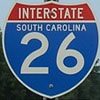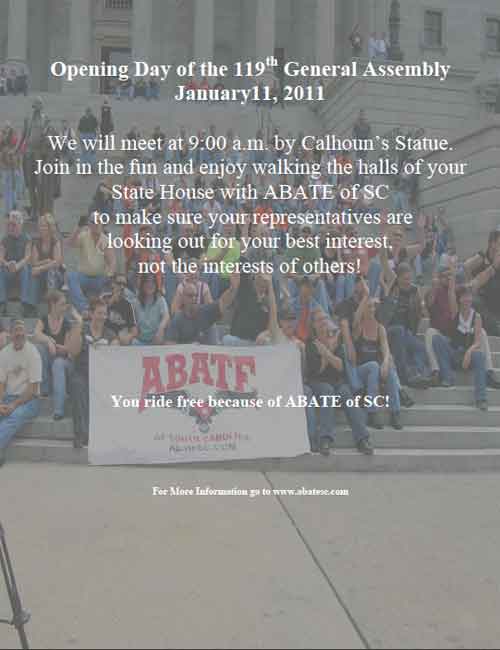 Image to the left taken from Interstate-Guide.com.
Image to the left taken from Interstate-Guide.com.
For many motorcyclists and automobile drivers who’ve traveled down Interstate 26 in South Carolina, it may come as a shock that the area that passes through Ridgeville is home to more fatal accidents than any other section of this bustling highway. According to a March 2010 article by The Post and Courier, “During the past decade, 325 people died in 286 wrecks on I-26 in South Carolina.” The article continued saying that one of the main reasons why there may be so many fatalities on this road is because of the lack of cable guardrail barriers.
I agree with this analysis since guardrails are notorious for their ability to save more lives in motor vehicle accidents. Although the lack of guardrails isn’t something in your immediate control to ensure your safety, there are precautionary measures you can take to help reduce your chances of being involved in a wreck on I-26.
Here are a few driving safety tips when traveling on I-26:
Remain Alert: According to this same Post and Courier article, “Some officials theorize that the quiet nature of the road can lull motorists into a false sense of security. After leaving the urban highway clutter of North Charleston and Summerville, I-26 has few distractions, other than, perhaps, a cross marking someone’s final drive.” If this theory is accurate, then it’s important that all drivers stay focused on the road and awake. If you’ve had a long day and are traveling back up to Columbia from Charleston, be sure that you are fit to drive and not too tired.
Don’t Travel in Bad Weather: Even if you’re a skilled driver in bad weather conditions, that doesn’t mean other drivers on the road are. Always stay alert when driving in bad weather. And if it’s difficult to see the road in front of you, pull over at the next rest stop or exit—try not to pull over on the shoulder since other motor vehicle drivers might not see your vehicle and could crash into your parked car.
Wear Your Seatbelt: It’s something you’ve heard again and again in your life, I know, but it’s worth repeating. Seatbelts have saved hundreds of thousands of lives and it could save yours to if you happen to be involved in a motor vehicle accident. Always buckle up before hitting the roads.
Share this post with your friends on Facebook.
Don’t miss the opening day of the 119th General Assembly happening in Columbia, South Carolina! Join ABATE (A Brotherhood Against Totalitarian Enactments) of South Carolina for Lobby Day, happening on Tuesday, January 11, 2011, and make your voice heard to your public servants in Columbia.
If you’re interested in joining ABATE and representing your rights and South Carolina biker rights, ABATE will be meeting on Tuesday, January 11, 2011 at 9 a.m. in front of the Calhoun statue at the Columbia State House (1101 Gervais Street, Columbia SC). During Lobby Day, you’ll be able to travel through the halls of the State House, with ABATE and their followers, to ensure that our public servants are looking out for our best interests and our rights.
To RSVP to this event, visit the ABATE Facebook page, here. Or share this post with your friends on Facebook.
View the flier for the Lobby Day event below:
For those of you who might not be familiar with ABATE of South Carolina, they are an organization based in South Carolina that represents the rights of motorcyclists across this great state. To learn more about ABATE of South Carolina, visit their website.
Don’t forget to share this post with your friends on Facebook and spread the word!
 The New Year is finally here and it’s that time again for deciding our 2011 New Year’s resolutions. The team at Uricchio Law Firm got together and wrote up a list of our 2011 New Year’s resolutions. We hope these resolutions give you some ideas, as well.
The New Year is finally here and it’s that time again for deciding our 2011 New Year’s resolutions. The team at Uricchio Law Firm got together and wrote up a list of our 2011 New Year’s resolutions. We hope these resolutions give you some ideas, as well.
See below:
Paul Uricchio—lawyer and manager / owner of Uricchio Law Firm: “To take an occasional day off.”
Terri: “To keep my boss happy.”
Chancho—our office pup: “To expand my picky palate”
Cristin & Katie—lawyers at Uricchio Law Firm: “To get our concealed weapons permits”
Dawn: “To not make any New Year’s Resolutions—it just sets yourself up for disappointment”
Mandi—Uricchio Law Firm’s legal assistant: “To lose the holiday pounds” (To which the rest of us at the firm say “BOOOOO”)
What’s your New Year’s resolution(s)?
Ringing in the New Year is one of the most exciting times of the year! Champagne, dancing, singing, and socializing, all wrapped up into one night is always a blast. Here, at Uricchio Law Firm, we’d like to wish you a happy and safe New Year’s. We’d also like to provide you with just a few safety tips to avoid personal injury and DUI charges this New Year’s Eve.
See below:
- Have a designated driver: If you’re going to be traveling during New Year’s Eve and New Year’s be sure to have a designated driver planned out for the evening. This decreases your chances and the chances of other drives from being involved in a motor vehicle accident, as well as eliminates your chances of being charged with a DUI. Also, there is often a much higher amount of police surveying the roads for drunk drivers.
- Try to stay off the roads as much as possible: Even if you have a designated driver for yourself, you cannot prevent drunk drivers and careless drivers from causing an accident with your vehicle. When you stay off the roads as much as possible, you automatically reduce your chances of being involved in a motor vehicle accident.
- Have a plan and stick to it: Before you go out for the night, decide who you will be going with, where you will be going, and what the environment will be like at your destination(s). Always stay with the friends you went to the party or bar with, especially if you are unfamiliar with the other individuals attending. Watch out for yourself and for your friends and never take a drink from an unfamiliar person. A rule of thumb is to always watch your drink being made and never lose sight of it from point A (the bar) to point B (your hand).
Stay safe and have a wonderful New Year’s!
What will you be doing this New Year’s Eve?
For motorcyclists in South Carolina or passing through this beautiful state, it’s important to be aware of all South Carolina motorcycle laws. We’ve compiled a few of our posts on SC motorcycle law for South Carolina visitors and residents, alike, to ensure you know your biker rights and understand the law, as well as remain safe on the road.
South Carolina Motorcycle Law:
 **Image above taken from Fun-Christmas-Ornaments.com
**Image above taken from Fun-Christmas-Ornaments.com
Uricchio Law Firm would like to wish all of our loyal blog readers safe and happy holidays! We’d also like to share with you some tips on how to stay safe and avoid personal injury this holiday season:
1. Travel Safely: Whether you’re traveling by motorcycle or motor vehicle, be extra alert and focused. With more volume on the roads and in shopping centers, it can be quite overwhelming.
2. Don’t Leave the Tree Lights On: If you’re not home, your tree lights should not be on. For years, tree lights have been the culprit of many house fires during this time of year.
3. Take Proper Precautions During Icy Winter Storms: No car, not even a four-wheel-drive car, can stabilize on ice. Be sure to practice caution while driving or walking, and be on the lookout for black ice (which looks like a dark patch of pavement).
We hope you enjoyed our safety tips for this holiday season and we wish you a very merry Christmas and happy holidays!
If you missed part I of this post, feel free to check it out here.
Only Smooth Moves:
Turning a motorcycle on such a slick surface demands an ultra-smooth approach. Getting on the brakes abruptly or making a sudden steering input could put you in the guardrail. So you want to be slowed down before you go in there and keep the throttle neutral all the way through –and be ready for cars that might get unstuck and block the whole mess.
That smooth approach to speed and direction changes will serve you well on all wet roads. Initiate your turns a bit more gradually. Downshift smoothly, engaging the clutch a bit slower than usual, and avoid abrupt throttle changes. Get on the throttle progressively. Use a taller gear to reduce the forces reaching the rear tire. Apply the brakes in such a way that the tires are not loaded abruptly. Allow more space to stop or slow down so that you need less. And also make sure that drivers around you have time to react to your moves.
The Eyes Need It: Though it might look better at the end of a long ride in the wet, a black rainsuit is going to be very hard to see in heavy rain.
**Image to the left taken from Motorcycle Superstore website.
That brings us back to vision. The ability of other drivers to see us could be the single biggest issue a motorcyclist must confront in the rain. With low light, windows obscured, and a streaked and possibly fogged windshield, the driver of a car may have a very difficult time seeing the world ahead. If you are wearing black, or even worse, a neutral color like gray or olive drab, you blend into that gray world. A bright yellow rainsuit is probably the best choice and the single simplest way to make your wet-weather rides safer, though white is also an excellent choice and even better than yellow at night. Fluorescent colors also help during the day and retro-reflective striping or panels on your rainsuit, helmet or a pack also help at night. A visible helmet color also makes a difference at night.
How about your own ability to see? Even with a faceshield that’s wet on both sides, you probably have a better view of the situation around you than the average car operator does in the rain. The drops on a faceshield (or goggles) are inside your focal point and are just vague blurs when you focus on the road ahead. However, your view can be impaired by faceshield fogging or a windshield that rises into your line of sight. Unlike a faceshield, a windshield is well out in your focal range, and the water on both sides makes it hard to see through. Rain-X does help disperse water on both face- and, more importantly, windshields.
Anti-fogging solutions and the Fog City Fog Shield effectively stop fogging, although the Fog Shield is not recommended for use at night because it creates some ghost images. Even if you don’t have a commercial anti-fog solution, a thin layer of hand or dish soap will stop fog. You can wipe it on wet or dry, than polish it off.
A Rainy Night:
For many motorcyclists, the demons come out on a rainy night. Each of those raindrops on your faceshield or goggles picks up a pinpoint of light from every light around you. Riding behind a windshield that is too tall to see over is extremely difficult, which is why we caution against that configuration. Oncoming cars can completely obscure your vision. A timely wipe of your faceshield can help, but you may be unable to see the road at all for a moment. Puddles may be completely undetectable.
On the other hand, lights that aren’t so bright — such as taillights — reflected in the road surface ahead can show you features of the road surface that you headlight doesn’t illuminate. My preferred strategy is to follow (at a distance that keeps me out of its spray) a vehicle with lots of taillights, watching the point where they are reflected to pick out potholes, seams, or objects lying in the road. Watching the vehicle will also warn you of large puddles, which could cause hydroplaning if you hit them fast enough.
Even at night a motorcyclist has a few aces to play. One advantage of a motorcycle is your high view point compared a person in a car. At night, this allows you a better view of the road surface because you have a steeper angle of view. As a result, it’s easier to see striping, and other shallow features. You can also use the reflective qualities of wet surfaces to your advantage. Wet utility wires or tree branches can warn you of a car approaching over a hill or around a corner. Brake lights reflected under a truck can alert you of an impending stop.
Did you find these bad weather motorcycle safety tips helpful? We’d love to hear from you in our comments section.
The weather in the South can be unpredictable. Storms can pop-up out of nowhere. Motorcycle riding in the rain safely is a matter of dressing properly, understanding traction, making sure you can see, and making sure that you are seen.
Gear-Up:
**Image to the right taken from the Motorcycle Superstore website.
Seeing and being seen are bigger concerns than traction.
The key element in being able to enjoy a day riding in the rain is good rain gear. These days virtually all rain-suits from
reputable motorcycle-accessory firms will keep you dry in a torrent. The factors that set some apart are ease of entry, conspicuous colors, and comfort.
There is nothing like a hard, biting rainstorm to convince someone of the advantage of a full-coverage helmet. Rain drops can hurt at 65 mph, so you want your face covered. You may also not want the dark lenses of your sun glasses. A full-coverage face-shield on an open-face helmet will block the rain drops, but lets more water get onto your face and drip down the inside of the shield of a full-face helmet.
Staying comfortable is important. Furthermore, if you get wet and cold, fatigue erodes that mental edge you need to stay ahead of the traffic around you.
Stick Like Glue:
Once you have dressed for the rain, you have only two motorcycle safety issues to confront: traction and vision. Traction seems to be the primary concern for most riders, usually because they aren’t sure how much grip they have available. While some surfaces–metal fixtures such as manhole covers and bridge gratings, painted areas, and places where built-up oil and grease have not washed off–become much slipperier when wet, you can actually call on a surprising amount of traction on clean asphalt or concrete.
How much? The easiest way to test traction is to feel for it with your rear brake.
Assuming you know how much deceleration you can develop on dry pavement before the rear tire breaks loose, you have a gauge of what’s available if you repeat the test when the road is wet. This also assumes that you have a reasonable amount (say 3/16 of an inch) of tread depth. If you do this at moderate speeds on a flat, straight road, it won’t become a thrill ride. Avoid locking up the rear wheel on a steeply crowned road, where it will tend to slide downhill and out of line.
You also can do a couple of things to improve traction. Premium aftermarket tires are virtually certain to give better wet-road grip than original-equipment tires. Also, a slight increase in tire pressure also improves the wet-weather traction of any tire. Increasing your tire pressure by five p.s.i. or less helps to cut through the film of water and prevent hydroplaning. Just don’t take that to mean you can venture out on bald tires with a bit more air in them.
Some situations should be confronted with extreme caution. Railroad tracks are extremely dangerous when wet. The standard advice is to try to cross railroad or other metal tracks at a right angle, even in the dry. When they are wet, this is imperative.
Otherwise, you risk having the tire slip into the groove alongside the track, which will immediately ruin your whole day.
Other large metal road surfaces or metal sections running parallel to your direction of travel — some expansion joints, for example — are equally hazardous and should be approached cautiously and upright. A thin strip of metal can usually be crossed while leaned over mildly; tires slip then catch again after crossing. However, a large metal surface such as a bridge grate, a manhole cover or a cattle guard, may permit the tire to slip too much to recover traction. Painted surfaces can be almost as slippery as metal.
Did you find these motorcycle safety tips helpful? If so, share them with your friends on Facebook.
As a Charleston SC motorcycle injury attorney, I’m pleased to present a guest video post from the highly acclaimed Charleston tax attorney, Evan Lacke. Evan was kind enough to provide us with a video on why we, as motorcyclists, need to have our estate documents in place.
See below for the video:
Learn more about Evan here, or connect with him on Facebook.







